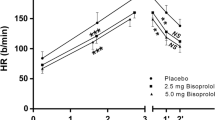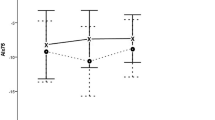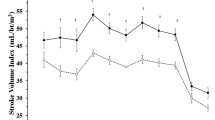Summary
This study compared the effects of clinically prescribed doses of atenolol, propranolol, diltiazem and a novel β1-selective antagonist, nebivolol, on maximal and submaximal exercise performance in physically active subjects. In a double-blind crossover trial, 11 healthy male volunteers performed progressive aerobic exercise to exhaustion for determination of maximal and submaximal oxygen consumption after subacute ingestion of atenolol, propranolol, nebivolol, diltiazem and placebo. Maximal oxygen consumption (V̇O2max), exercise time to exhaustion and peak workload were decreased by propranolol and atenolol (p < 0.05) vs placebo. Peak heart rate (p < 0.01) and submaximal systolic blood pressure (p < 0.05) were reduced by nebivolol, atenolol and propranolol vs placebo. There was no intergroup variation in peak submaximal minute ventilation, the peak respiratory exchange ratio, peak blood lactate concentrations and lactate accumulation with increase in work rate. Although there were no differences between drugs in submaximal oxygen consumption, minute ventilation and blood lactate concentrations, ratings of perceived exertion were increased on all 3 β-receptor antagonists during submaximal exercise. We conclude that nebivolol, atenolol and propranolol but not diltiazem lower systolic blood pressure during exercise. Maximal aerobic performance was impaired by atenolol and propranolol but not by nebivolol and diltiazem. Unlike other β-receptor antagonists, nebivolol lowered blood pressure and heart rate but did not appear to affect maximal aerobic exercise performance.
Similar content being viewed by others
References
Borg GAV. Psychophysical bases of perceived exertion. Medicine and Science in Sports and Exercise 14: 377–381, 1982
De Crée J, Cobo C, Geukens H, Verhaegen H. Comparison of the subacute haemodynamic effects in volunteers of atenolol, propranolol, pindolol, and nebivolol, a novel, selective beta-1-adrenergic antagonist with an unusual haemodynamic profile. Angiology 41: 95–105, 1990
De Crée J, Geukens H, Verhaegen H. Haemodynamic effects of nebivolol in 15 hypertensive patients. Acta Antwerpiensia 6: 37–41, 1989
Ekblom B, Goldbarg AN, Kilbom A, Astrand PO. Effects of atropine and propranolol on the oxygen transport system during exercise in man. Scandinavian Journal of Clinical and Laboratory Investigation 30: 35–42, 1972
Glanz SA. Biostatistics: how to detect, correct and prevent errors in the medical literature. Circulation 61: 1–7, 1980
Hughson RL, Green HJ, Alway SE. The effects of electrically stimulated contraction in fatigued human triceps surae muscle. Clinical Physiology 7: 133–150, 1987
Jilka SM, Joyner MJ, Nittolo JM, Kalis JK, Taylor JA, et al. Maximal exercise responses to acute and chronic beta-adrenergic blockade in healthy male subjects. Medicine and Science in Sports and Exercise 20: 570–573, 1988
Joyner MJ, Freund BJ, Jilka SM, Hetrick GA, Martinez E, et al. Effects of beta-blockade on exercise capacity of trained and untrained men: a hemodynamic comparison. Journal of Applied Physiology 60: 1429–1434, 1986
Matter M, Sittfall T, Adams B, Myburgh K, Graves J, et al. The effects of iron and folate therapy on maximal exercise performance in iron and folate deficient runners. Clinical Science 72: 415–422, 1987
Noakes TD, Myburgh K, Schall R. Peak treadmill running velocity during the VC>2max test predicts running performance. Journal of Sports Sciences 8: 35–45, 1990
Noakes TD. Implications of exercise testing for prediction of athletic performance: a contemporary perspective. Medicine and Science in Sports and Exercise 20: 319–330, 1988
Report of the Joint National Committee on Detection, Evaluation, and Treatment of High Blood Pressure. Archives of Internal Medicine 144: 1045–1057, 1984
Tesch PA, Kaiser P. Effect of beta-adrenergic blockade on oxygen uptake during submaximal and maximal exercise. Journal of Applied Physiology: Respiratory, Environmental and Exercise Physiology 54: 901–905, 1983
Van Baak MA, Koene FMM, Verstappen FTJ. Exercise haemodynamics and maximal exercise capacity during beta-adrenoceptor blockade in normotensive and hypertensive subjects. British Journal of Clinical Pharmacology 25: 169–178, 1988
Author information
Authors and Affiliations
Rights and permissions
About this article
Cite this article
Derman, E.W., Haus, M., Dunbar, F. et al. Cardiovascular, Respiratory and Metabolic Effects of Nebivolol During Maximal and Submaximal Exercise Performance. Drug Invest 3 (Suppl 1), 33–39 (1991). https://doi.org/10.1007/BF03258261
Published:
Issue Date:
DOI: https://doi.org/10.1007/BF03258261




